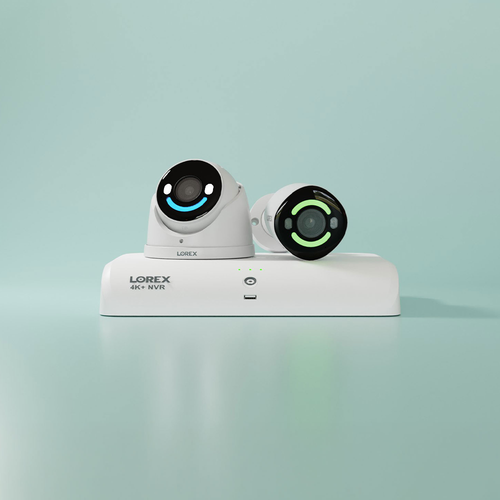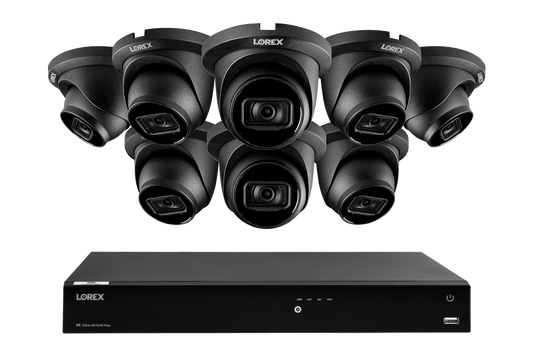Collection: Wired Security Cameras & Systems
Whether you need an add-on camera or a complete 24/7 wired surveillance system, we have the perfect security solution for you.
-

Build Your Own System - H Series 4K+ (12MP) IP Security Cameras with 16-Channel (8 Wired, 8 Wi-Fi) Fusion Recorder
Sale4.4 / 5.0
(51) 51 total reviews
Regular price From $439.25Sale price From $439.25 / eachRegular price$669.98Sale -

Nocturnal Series Lorex 4K IP Wired Dome Security Camera with Listen-in Audio and Real-Time 30FPS Recording
Sold out
Nocturnal Series Lorex 4K IP Wired Dome Security Camera with Listen-in Audio and Real-Time 30FPS Recording
4.6 / 5.0
(129) 129 total reviews
Regular price $169.99Sale price $169.99 / eachRegular priceSold out -

H Series Lorex 4K IP Wired Dome Security Camera with Smart Deterrence and Smart Motion Detection
SKU: E893DD-E
4.8 / 5.0
(142) 142 total reviews
Regular price $139.99Sale price $139.99 / eachRegular priceSold out -

Nocturnal Series Lorex 4K IP Wired Bullet Security Camera with Listen-in Audio and Real-Time 30FPS Recording
4.9 / 5.0
(126) 126 total reviews
Regular price $169.99Sale price $169.99 / eachRegular price -

Fusion Series Lorex Fusion 4K 16 Camera Capable (Wired / Fusion Wi-Fi) 4TB NVR
SKU: N864A64B
4.4 / 5.0
(176) 176 total reviews
Regular price $459.99Sale price $459.99 / eachRegular price$569.99Save $110 (19%)Sale -

Nocturnal Series Lorex 4K IP Wired Bullet Security Camera with Motorized Varifocal Lens and Real-Time 30FPS Recording
4.7 / 5.0
(82) 82 total reviews
Regular price $249.99Sale price $249.99 / eachRegular price -

Fusion DVR Lorex Fusion 4K 12 Camera Capable (8 Wired and 4 Wi-Fi) 2TB DVR
SKU: D881A82B
4.6 / 5.0
(276) 276 total reviews
Regular price $269.99Sale price $269.99 / eachRegular price$329.99Save $60 (18%)Sold out -

Nocturnal Series Lorex 4K IP Wired Dome Security Camera with Listen-In Audio, Motorized Varifocal Lens and Real-Time 30FPS Recording
4.7 / 5.0
(43) 43 total reviews
Regular price $249.99Sale price $249.99 / eachRegular price -

H Series Lorex 4K IP Wired Bullet Security Camera with Smart Security Lighting and Smart Motion Detection
4.7 / 5.0
(74) 74 total reviews
Sold out -
H Series Lorex H20 4K IP Wired Dual Lens Security Camera with Smart Security Lighting and Smart Motion Detection
SKU: E871AB
4.6 / 5.0
(137) 137 total reviews
Regular price $279.99Sale price $279.99 / eachRegular price -
A Series Lorex A14 IP Wired Dome Security Camera with Listen-In Audio and Smart Motion Detection
4.6 / 5.0
(87) 87 total reviews
Regular price $119.99Sale price $119.99 / eachRegular price -
A Series Lorex A14 IP Wired Bullet Security Camera with Listen-In Audio and Smart Motion Detection
4.7 / 5.0
(79) 79 total reviews
Regular price $119.99Sale price $119.99 / eachRegular price -

H Series Lorex H16 4K IP Wired Dome Security Camera with Smart Security Lighting and Smart Motion Detection
4.8 / 5.0
(27) 27 total reviews
Sold out -

A Series Lorex Fusion Series 4K 16 Camera Capable (Wired or Fusion Wi-Fi) 4TB Wired NVR System with A14 IP Dome Cameras
4.4 / 5.0
(32) 32 total reviews
Regular price From $1,173.00Sale price From $1,173.00 / eachRegular price$1,379.00Save $206 (15%)Sale -
Lorex Fusion 4K 12 Camera Capable (8 Wired + 4 Wi-Fi) 2TB Wired DVR System with Active Deterrence Bullet Cameras
4.3 / 5.0
(81) 81 total reviews
Regular price From $365.00Sale price From $365.00 / eachRegular price$429.00Save $64 (15%)Sold out -

A Series Lorex Fusion Series 4K 16 Camera Capable (Wired or Fusion Wi-Fi) 4TB Wired NVR System with A14 IP Bullet Cameras
4.4 / 5.0
(39) 39 total reviews
Regular price From $1,173.00Sale price From $1,173.00 / eachRegular price$1,379.00Save $206 (15%)Sale
Popular Collections
Frequently Asked Questions About Lorex
Collapsible content
Why Is Lorex a Leader in Home and Business Security?
Proudly founded and still headquartered in Markham, ON, Canada, Lorex is a trusted provider of security cameras and complete security camera systems, serving consumers for over 30 years. We are recognized for delivering high-quality DIY security solutions with user-friendly, reliable, and advanced security technology for both homes and businesses.
Lorex products are available through authorized retailers and our official online store. With headquarters in Markham, Ontario, Canada, and Linthicum, Maryland, USA, and warehouses in Indiana, California, and Canada, we ensure fast and efficient delivery to our customers.
Why do I need security cameras?
Investing in security cameras for your home or business offers several crucial benefits:
• Crime Deterrence – Visible security cameras can discourage potential intruders before they act.
• 24/7 Surveillance – Lorex security cameras provide high-quality recordings, including 4K video resolution and night vision, capturing every important detail.
• Remote Monitoring – Stay connected with your security system through Lorex mobile apps that allow real-time viewing from anywhere.
• Evidence Collection – In case of an incident, recorded footage can serve as vital proof for authorities.
• Peace of Mind – Enjoy enhanced home security and workplace safety with smart monitoring features like motion detection, two-way talk, and smart home integration.
Do Lorex security cameras support cloud storage?
Yes, Lorex provides optional Lorex Cloud Storage plans to enhance the security and convenience of your video footage. These plans are designed for select compatible Lorex Cloud Storage Cameras, offering an additional layer of protection by securely storing your recordings in the cloud. This ensures your footage is safe from risks like theft, damage, or local storage failure.
Key features of Lorex Cloud Storage include:
• Flexible storage options – Access your recorded video footage for up to 30 days.
• High-resolution recording support – Cloud storage supports resolutions up to 4K for detailed and crisp video playback.
• Secure and remote access – View, download, and share your recordings from anywhere - even if your camera doesn't have power.
Lorex offers different plans tailored for single or multiple cameras at a single location. While Lorex Cloud Storage Cameras include built-in local storage and do not require a subscription to function, a cloud subscription provides added convenience and peace of mind.
How do I install Security Cameras?
Lorex security cameras are designed for easy DIY installation, with options suited for different home or business setups:
• Wired Security Cameras & Systems: These systems require a physical cable connection between the camera and the Security Recorder (NVR or DVR)
• Wireless (Wi-Fi) Security Cameras: Indoor and Outdoor Wireless Cameras connect wirelessly to your network but require power through an outlet. In some cases, such as with wired Doorbell Cameras and Floodlight Security Cameras, they are hardwired into your existing doorbell or light fixture wiring for power.
• Battery-Operated Cameras & Systems: Battery-operated security cameras offer completely cord-free surveillance with rechargeable power. Available in two types: some integrate with security systems, wirelessly transmitting footage to a recorder for centralized storage, while others function as Wireless Cameras with local and/or Lorex Cloud Storage, connecting directly to your network for remote access via the Lorex app.
For a step-by-step installation guide, check out our How to Install Security Cameras article.
Are Lorex security cameras compatible with smart home devices?
Yes, many Lorex smart home security cameras and Security Recorders are designed to integrate seamlessly with smart home devices, enhancing convenience and connectivity. Lorex cameras work with popular platforms such as:
• Amazon Alexa: Use voice commands to display live camera feeds on Alexa-enabled devices like Echo Show or Fire TV.
• Google Assistant: View your security camera’s footage on Google Nest Hub or Chromecast-enabled devices with simple voice prompts.
By connecting Lorex cameras to your smart home devices, you can centralize your home automation system and monitor your property more efficiently. Compatibility may vary by camera model, so be sure to check product specifications.
Can I access my security cameras remotely?
Yes, both Lorex Wired Security Systems and Lorex Smart Home Wireless (Wi-Fi) Security Cameras offer robust remote viewing capabilities through their suite of Lorex mobile apps, allowing you to monitor your property from virtually anywhere. Depending on your specific device and/or system, you can utilize apps such as the Lorex App, Lorex Cirrus App, or Lorex Pro App.
Key features across these apps include:
• Live View and Playback: Watch real-time footage and review recorded videos directly from your mobile device.
• Motion Event Timelines: Easily locate and review motion events with organized timelines, eliminating the need to sift through hours of footage.
• Motion Notifications: Receive instant alerts for motion events, keeping you informed of any activity.
• Camera and System Settings: Customize various settings, including resolution adjustments, recording preferences, and motion detection zones, to tailor the system to your needs.
• Save Videos and Snapshots: Manually record and save important video clips or snapshots for future reference or sharing.
These applications are available for both iOS and Android devices, providing a user-friendly interface to manage your security system efficiently. For more detailed information and to determine the best app for your specific system, please visit Lorex Mobile Apps page.
Why Buy Security Cameras from Lorex?
Choosing Lorex means investing in high-quality security solutions designed to deter crime, capture every moment (good or bad), and protect what matters most.
• Industry Expertise – Over 30 years of experience in developing cutting-edge security technology.
• Top-Tier Features – Includes 4K Ultra HD recording, Color Night Vision, Smart Motion Detection, and Active Deterrence.
• Highly Rated Apps – Stay connected to your security system with intuitive Lorex mobile apps, designed for seamless remote viewing, playback, and notifications.
• No Monthly Fees Required — Lorex gives you the option for local storage with built-in microSD slots or hard drive bays.
• Reliable Customer Support – Enjoy free shipping (over $100), a 1-year warranty, and a 30-day money-back guarantee for worry-free purchases. Need help? Contact Us for anything from pre-purchase questions to technical support.
Have more questions?
Visit our Frequently Asked Questions (FAQ) page to learn more about Lorex security cameras, technology, and Lorex mobile app features.


















